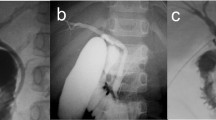Abstract
Pancreaticobiliary maljunction (PBM) is a congenital anomaly defined as a union of the pancreatic and biliary duct that is located outside the duodenal wall. The Japanese Study Group on Pancreaticobiliary Maljunction and the Committee for Registration enrolled and analyzed 1627 patients with PBM who had been diagnosed and treated from January 1, 1990 to December 31, 1999 at 141 hospitals throughout the country. There were 1239 patients with dilatation of the bile duct (group A) and 388 patients without dilatation (group B). The average age was 24 years in group A and 47 years in group B; the age was significantly higher in group B. The type of confluence between the terminal choledochus and the pancreatic duct has been classified into three types (type a, right-angle type; type b, acute-angle type; and type c, complex type). In group A, type a accounted for 57.9% and was significantly more frequent compared with the other types (type b, 32.4%; type c, 5.6%). In group B, type b accounted for 60.8%, being significantly more frequent compared with the other types (type a, 29.4%; type c, 7.2%). Subjective symptoms, preoperative complications (e.g., liver dysfunction and acute pancreatitis), pancreatic stone, and pancreatic duct morphological abnormality were significantly more frequent in group A. However, the amylase levels in the bile and gallbladder were significantly higher in group B, and the presence of gallstone and morphological abnormality of the gallbladder was significantly more frequent in group B. The occurrence rate of cancer in the biliary tract was 10.6% in group A and 37.9% in group B, being significantly higher in group B. In group A, cancer of the extrahepatic bile duct was seen in 33.6% and cancer of the gallbladder was seen in 64.9%, but gallbladder cancer was present significantly more frequently in the patients with diffuse or cylindrical dilatation, and bile duct cancer was present significantly more frequently in the patients with cystic dilatation. In group B, 93.2% of the patients had gallbladder cancer, and bile duct cancer was found in as few as 6.8%. Against this background Japanese surgeons regard cholecystectomy, resection of the extrahepatic bile duct, and hepaticojejunostomy as standard operations for PBM with dilatation of the bile duct. However, opinion on whether or not the bile duct should be removed in the treatment of PBM without dilatation of the bile duct has been divided among Japanese surgeons. A randomized controlled trial is necessary.
Similar content being viewed by others
Author information
Authors and Affiliations
About this article
Cite this article
Tashiro, S., Imaizumi, T., Ohkawa, H. et al. Pancreaticobiliary maljunction: retrospective and nationwide survey in Japan. J Hepatobiliary Pancreat Surg 10, 345–351 (2003). https://doi.org/10.1007/s00534-002-0741-7
Received:
Accepted:
Issue Date:
DOI: https://doi.org/10.1007/s00534-002-0741-7




